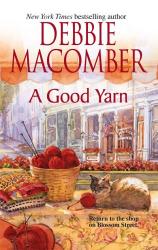Reading Group Guide
Discussion Questions
A Good Yarn

1. There has been a recent --- and growing --- resurgence of interest in knitting. Why do you think that is? What draws each of these characters --- Lydia, Bethanne, Elise and Courtney --- to the activity of knitting? Do you think there are reasons beyond the obvious ones they themselves give?
2. The shop, A Good Yarn, symbolizes Lydia's hope for --- and belief in --- the future after her triumph over cancer in The Shop on Blossom Street. It's now a successful business. Do you think the shop's meaning has changed?
3. All the characters in this book are coping with or recovering from some form of loss --- financial loss in Elise's case, the loss of a marriage in Bethanne's, the loss of her mother and absence of family in Courtney's. Even Lydia undergoes the loss (temporary though it turns out to be) of the man she loves --- and the beginning stages of losing her mother. What does each woman learn from these experiences? Does loss diminish them or make them stronger? Do their growing friendships --- and their knitting --- contribute to their ability to absorb and transcend their losses?
4. In your view, is there a particular significance to the fact that the women are knitting socks? Debbie Macomber has said that the socks are, in part, a reference to the old saying, "Walk a mile in my shoes," which suggests the importance of both compassion and tolerance. How is this relevant to the story? Are the socks themselves integral to A Good Yarn --- or could Lydia's class have been knitting anything?
5. Friendship, especially friendships among women, is an important theme in this author's stories. What role does knitting play in the forming of these friendships? Is there something special about knitting --- does it bring something unique to the relationships in the story that some other activity would not have? One of the quotes in the book, from Mary Colucci, suggests that "Knitters just naturally create communities of friends...." Do you agree?
6. According to another quote, this one from knitting designer Nancy Bush, "Making a sock by hand creates a connection to history...." In other words, knitting connects the knitter to the past. How? Is that a factor in this story? As Debbie Macomber has said, it's also about the importance of having faith in the future. Are these two beliefs mutually exclusive?
7. Another theme that plays a key role in Debbie Macomber's books is the concept of home and community. How important is that in this story --- and to the various characters? As well, it could be said that each of these characters becomes part of more than one new community. Do you agree that, for them, belonging to this small community of knitters is where it all starts?
8. Each character helps at least one of the others in some important way. For instance, Elise encourages and inspires Bethanne to start her own business, Courtney rescues Annie from a dangerous situation, Lydia gives Margaret money, and so on. The ultimate is Maverick's "Fairy Godfather." Do you think it's fair to say that the giver derives as much benefit and pleasure as the recipient? In what ways? Would you agree that these characters practice the "pay it forward" philosophy --- passing on whatever good has been done for them?
9. In Debbie Macomber's stories, there is often a balance between solving one's own problems and accepting the help and guidance of others. Do you find that to be true here? What is the relationship between the two?
10. The shop and the story are both called A Good Yarn. The knitting sessions are a chance for the women to tell their own stories and to listen to one another's --- to share their "yarns" in more ways than one. Do you feel knitting and storytelling share a natural connection?
A Good Yarn
- Publication Date: May 1, 2006
- Genres: Fiction
- Mass Market Paperback: 400 pages
- Publisher: Mira
- ISBN-10: 0778322955
- ISBN-13: 9780778322955








